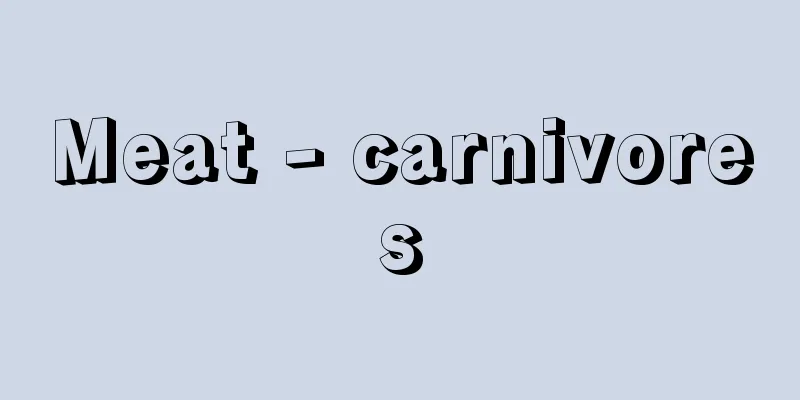Meat - carnivores

|
A general term for animals belonging to the order Carnivora in the class Mammalia. Members of this order Carnivora are medium to large, sophisticated animals, some of which are omnivorous or mostly herbivorous, but these have changed their diet secondary to the point that they were originally predators that mainly fed on vertebrates. They always have large fang-like canines, the fourth premolar of the upper jaw and the first molar of the lower jaw have been modified into carnassial teeth for cutting meat, and the carpal bones are strong, with the navicular and lunate bones fused together (and in modern species, the central bone is also fused with them). They live on land or in trees, or rarely in water, and walk on all four limbs, plantigrade, semiplantigrade, or digitigrade. They have four or five clawed fingers on their feet. They have a single stomach and short intestines, and their sensory organs such as eyes, ears, nose, and tentacles, as well as a well-developed cerebrum, making them highly intelligent. Their clavicles have degenerated, and their placenta is band-shaped. They have well-developed scent glands such as the anal gland and perineal sac (civet cat), which they use to mark their territory. They generally give birth to small numbers of offspring, which are raised by their parents for a long time while they learn hunting techniques. With the exception of those artificially introduced, they do not live in Australia, New Guinea, New Zealand, Antarctica, etc., but are found on other continents and surrounding islands, and live alone or in groups in a variety of environments from the tropics to the polar regions, including forests, grasslands, deserts, tundra, rivers (otters), and oceans (sea otters), and some sometimes hibernate. Modern species branched off from the Miacoidea, an order of creatures whose central bone was not fused to the scaphoid and lunate bones, in the Paleocene of the Tertiary Period, and there are about 240 species in eight families in three superfamilies: the Ursoidea (Ursidae, Pandas, Procyonidae, Mustelidae), the Mongooseoidea (Viverridae, Hyaenas), and the Canoidea (Canidae, Felidae). The Paleocene creodont Creodonta was once thought to be a suborder of the Carnivora, but has recently been discovered to belong to a completely separate lineage. Most carnivores are predators near the top of the food chain, and require vast territories (hunting grounds) with many prey to survive, so their populations are far smaller than herbivores. Furthermore, many of them are wild animals that are dangerous to humans and livestock, or produce high-quality fur, and have long been the subject of extermination or hunting. As a result, many of them, such as the Falkland Islands wolf, Japanese wolf, and Cape lion, are extinct, and many, such as the American red wolf and the Iriomote wildcat, are on the verge of extinction, and are considered in need of strict protection under the Convention on International Trade in Endangered Species (CITES) and other treaties. Species that produce high-quality fur (mink, fox, etc.) are farmed for fur in Canada, the Russian Federation, and other countries, and are already semi-domesticated. Marine mammals such as sea lions, walruses, and seals are closely related to bears and weasels, and were once considered to be a suborder of the order Carnivora (suborder Pinnipedia). However, because their morphology and ecology are significantly different, in recent years they are often considered to be an independent order (order Pinnipedia). [Yoshinori Imaizumi] Source: Shogakukan Encyclopedia Nipponica About Encyclopedia Nipponica Information | Legend |
|
哺乳(ほにゅう)綱食肉目に属する動物の総称。この目Carnivoraの仲間は、中形ないし大形の洗練された体制をもった獣で、なかには雑食やほとんど植物食のものもあるが、それらは二次的に食性が変わったもので、本来は脊椎(せきつい)動物を主食とする捕食者であった。つねに牙(きば)状の大きな犬歯を備え、上顎(じょうがく)の第4前臼歯(きゅうし)と下顎の第1臼歯が肉を切る裂肉歯に変化し、手根骨は舟状骨と月状骨が癒着(現生の類では中心骨もそれらと癒着)して頑丈になっている。地上または樹上生、まれに水生で、四肢で歩き、蹠行(しょこう)、半蹠行、または指行性。足には鉤(かぎ)づめを備えた指が4、5本ある。胃が単一で腸が短く、目、耳、鼻、触毛などの感覚器官と大脳が発達し知能が高い。鎖骨は退化し、胎盤は帯状。肛門腺(こうもんせん)、会陰嚢(えいんのう)(ジャコウネコ)などの臭腺が発達し、その分泌液を縄張りの印づけなどに使う。産子数は一般に少なく、子は長い間親に育てられ、狩りの技術などを学ぶ。人為的に移入したものを除けばオーストラリア、ニューギニア島、ニュージーランド、南極大陸などには生息しないが、それ以外の大陸と周辺の島に分布し、単独または群れで熱帯から寒帯までの森林、草原、砂漠、ツンドラ、川(カワウソ)、海(ラッコ)などあらゆる環境にすみ、ときに冬眠するものがある。現生の類は、中心骨が舟状・月状骨と癒着していない第三紀暁新世のミアキス上科Miacoideaから分かれ出たもので、クマ上科(クマ科、パンダ科、アライグマ科、イタチ科)、マングース上科(ジャコウネコ科、ハイエナ科)、イヌネコ上科(イヌ科、ネコ科)の3上科8科約240種がある。暁新世の肉歯類Creodontaは、かつては食肉目の1亜目と考えられていたが、近年まったく別の系統のものと判明した。 食肉類の多くは食物連鎖の頂上近く位置する捕食者で、生命を維持するには、多数の獲物がすむ広大な縄張り(狩り場)を必要とするため、草食動物に比べて個体数がはるかに少ない。そのうえ、人畜に危害を及ぼす猛獣や毛皮の優良なものが多く、古くから駆除や狩猟の対象とされてきたので、フォークランドオオカミ、ニホンオオカミ、ケープライオンなどのように絶滅したものや、アメリカアカオオカミ、イリオモテヤマネコのように絶滅に瀕(ひん)したものが多く、ワシントン条約などによる厳重な保護が必要と考えられている。毛皮の優良な種類(ミンク、キツネなど)は、カナダ、ロシア連邦などで毛皮獣として養殖され、すでになかば家畜となっている。 なお、アシカ、セイウチ、アザラシなどの海獣はクマ類やイタチ類に近縁で、かつては食肉目の1亜目(鰭脚(ききゃく)亜目)とされていたが、形態や生態が顕著に異なるため、近年は独立の目(鰭脚目)とされることが多い。 [今泉吉典] 出典 小学館 日本大百科全書(ニッポニカ)日本大百科全書(ニッポニカ)について 情報 | 凡例 |
<<: Shoku Nihongi - Shoku Nihongi
>>: Meat processing - Shokunikukakou
Recommend
Public Health Center - Hokenjo
Public health centers are public institutions tha...
Tamagushi
It is also written as tamagushi. It is also calle...
《Ayande》 - Ayande
…The amount of publications has also increased en...
Utagahama Beach
... Mt. Nantai is a sacred place of mountain wors...
Democratic Alliance for the Defense of African People's Interests
... In 1946, the Congolese Progressive Party (PPC...
Casuistry
From the Latin casus, meaning "case," it...
Fuseli, H.
…Born in Zurich. He spent most of his artistic ca...
Yu-wen Hu (English spelling)
[Raw] Taiwa 19 (495) [Died] Kentoku 1 (572) The po...
Kaihoji Temple
…After the Longhai Railway was opened, some moder...
Setana [town] - Setana
A former town in Setana District, Hokkaido. A port...
Ironsi, A. (English spelling) IronsiA
...Against this political turmoil, a military cou...
Sima Chengzhen - Shiba Shōtei (English spelling)
647‐735 A leader of the Shangqing sect of Taoism d...
National Museum of Rome - Museo Nazionale Romano
This museum in Rome is one of the most representa...
Kirov with us - Kirov with us
…He was once a member of the literary group Serap...
Pigeon (Dove) - Columba
Its abbreviation is Col. It is a small constellati...









